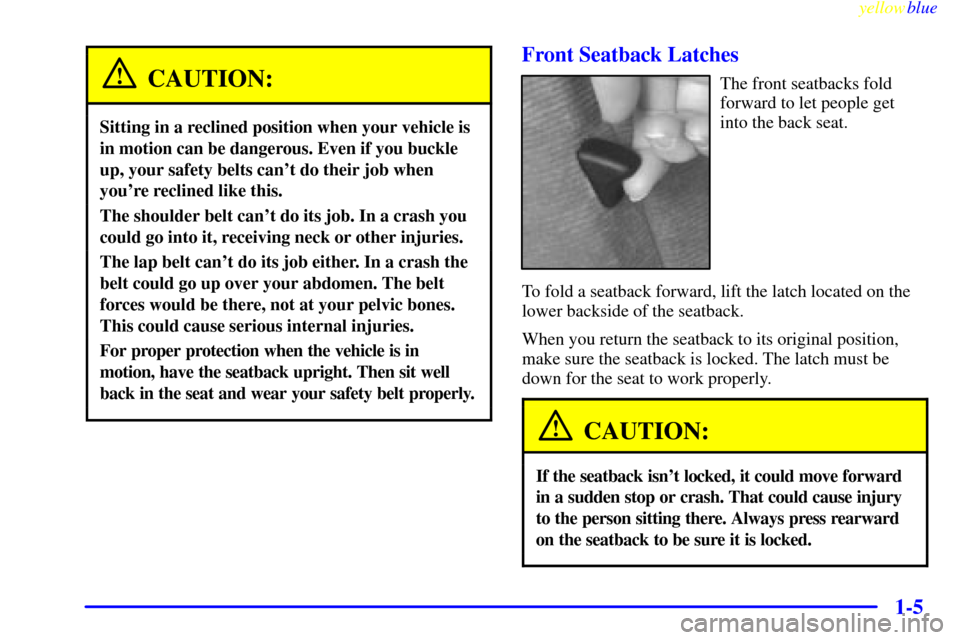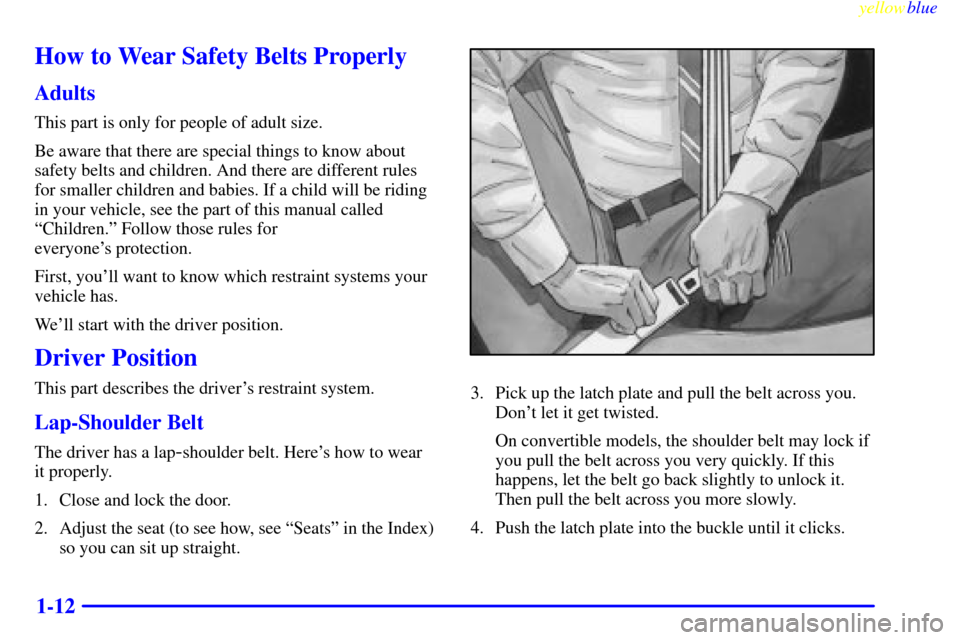Page 4 of 376
yellowblue
iv
In 1932 Chevrolet
introduced the
Synchro
-Mesh
transmission and
offered a host of
accessories -- including
such niceties as a clock!The legacy of America's favorite sportscar
began in 1953, when 319 hand
-assembled
white Corvettes
launched the
first use of a
fiberglass body in
a production car.
The Chevrolet blend of
value and performance has
become an American
tradition -- whether bred for
the racetrack like the legendary
Corvette and Camaro, or created for the pleasure of the
open road.
Every decade, Chevrolet
has reinforced its heritage
of affordable performance
with quality and value crafted into each vehicle. It's not
surprising that for 80 years
ªGenuine Chevroletº has been
America's automobile.
We're proud to continue that
heritage in your Chevrolet,
Page 8 of 376
yellowblue
viii
For example,
these symbols
are used on an
original battery:
CAUTION
POSSIBLE
INJURY
PROTECT
EYES BY
SHIELDING
CAUSTIC
BATTERY
ACID COULD
CAUSE
BURNS
AVOID
SPARKS OR
FLAMES
SPARK OR
FLAME
COULD
EXPLODE
BATTERY
These symbols
are important
for you and
your passengers
whenever your
vehicle is
driven:
DOOR LOCK
UNLOCK
FASTEN
SEAT
BELTS
POWER
WINDOW
AIR BAG
These symbols
have to do with
your lamps:
MASTER
LIGHTING
SWITCH
TURN
SIGNALS
PARKING
LAMPS
HAZARD
WARNING
FLASHER
DAYTIME
RUNNING
LAMPS
FOG LAMPS
These symbols
are on some of
your controls:
WINDSHIELD
WIPER
WINDSHIELD
WASHER
WINDSHIELD
DEFROSTER
REAR
WINDOW
DEFOGGER
VENTILATING
FAN
These symbols
are used on
warning and
indicator lights:
ENGINE
COOLANT
TEMP
BATTERY
CHARGING
SYSTEM
BRAKE
COOLANT
ENGINE OIL
PRESSURE
ANTI-LOCK
BRAKES
Here are some
other symbols
you may see:
FUSE
LIGHTER
HORN
SPEAKER
FUEL
Vehicle Symbols
These are some of the symbols you may find on your vehicle.
Page 10 of 376
yellowblue
1-2
Seats and Seat Controls
This section tells you about the seats -- how to adjust
them and also about reclining front seatbacks, seatback
latches and the folding rear seatback.
Manual Front Seat
CAUTION:
You can lose control of the vehicle if you try to
adjust a manual driver's seat while the vehicle is
moving. The sudden movement could startle and
confuse you, or make you push a pedal when you
don't want to. Adjust the driver's seat only when
the vehicle is not moving.
Move the lever under the passenger's front seat to
unlock it.
Slide the seat to where you want it. Then release the
lever and try to move the seat with your body to make
sure the seat is locked into place. Be sure the lever
returns to its original position after moving the seat.
Page 11 of 376
yellowblue
1-3 4-Way Manual Seat
There are two levers at the front of the seat. The left
lever adjusts the seat forward and rearward. The right
lever adjusts the angle of the front of the seat.
To adjust the seats forward and rearward, lift the lever
under the left front of the seat. Slide the seat to where
you want it. Then release the lever and try to move the
seat with your body to make sure the seat is locked
into place.
To raise or lower the entire seat, lift the lever under the
right front of the seat and lean forward or backward.
6-Way Power Seat (If Equipped)
The driver's seat has three controls on the left side.
A: The front control makes the front of the seat go up
and down.
B: The center control makes the whole seat go up and
down or forward and backward.
C: The back control makes the back of the seat go up
and down.
Page 12 of 376
yellowblue
1-4 Reclining Front Seatbacks
To adjust the seatback, lift the lever on the outer side of
the seat. Release the lever to lock the seatback where
you want it. Pull up on the lever and the seat will go to
its original upright position.But don't have a seatback reclined if your vehicle
is moving.
Page 13 of 376

yellowblue
1-5
CAUTION:
Sitting in a reclined position when your vehicle is
in motion can be dangerous. Even if you buckle
up, your safety belts can't do their job when
you're reclined like this.
The shoulder belt can't do its job. In a crash you
could go into it, receiving neck or other injuries.
The lap belt can't do its job either. In a crash the
belt could go up over your abdomen. The belt
forces would be there, not at your pelvic bones.
This could cause serious internal injuries.
For proper protection when the vehicle is in
motion, have the seatback upright. Then sit well
back in the seat and wear your safety belt properly.
Front Seatback Latches
The front seatbacks fold
forward to let people get
into the back seat.
To fold a seatback forward, lift the latch located on the
lower backside of the seatback.
When you return the seatback to its original position,
make sure the seatback is locked. The latch must be
down for the seat to work properly.
CAUTION:
If the seatback isn't locked, it could move forward
in a sudden stop or crash. That could cause injury
to the person sitting there. Always press rearward
on the seatback to be sure it is locked.
Page 14 of 376

yellowblue
1-6 Folding Rear Seatback
The rear seatback in your vehicle folds down to provide
more storage space.
To fold the seatback down:
1. Pull forward on both levers.
2. Fold the seatback down.
To raise the seatback:
1. Pull it up to the locked, upright position.
2. Be sure both latches hold the seatback in place. Have
them fixed if they don't.
Safety Belts: They're for Everyone
This part of the manual tells you how to use safety belts
properly. It also tells you some things you should not do
with safety belts.
And it explains the air bag system.
CAUTION:
Don't let anyone ride where he or she can't wear
a safety belt properly. If you are in a crash and
you're not wearing a safety belt, your injuries
can be much worse. You can hit things inside the
vehicle or be ejected from it. You can be seriously
injured or killed. In the same crash, you might
not be if you are buckled up. Always fasten your
safety belt, and check that your passengers' belts
are fastened properly too.
Page 20 of 376

yellowblue
1-12
How to Wear Safety Belts Properly
Adults
This part is only for people of adult size.
Be aware that there are special things to know about
safety belts and children. And there are different rules
for smaller children and babies. If a child will be riding
in your vehicle, see the part of this manual called
ªChildren.º Follow those rules for
everyone's protection.
First, you'll want to know which restraint systems your
vehicle has.
We'll start with the driver position.
Driver Position
This part describes the driver's restraint system.
Lap-Shoulder Belt
The driver has a lap-shoulder belt. Here's how to wear
it properly.
1. Close and lock the door.
2. Adjust the seat (to see how, see ªSeatsº in the Index)
so you can sit up straight.
3. Pick up the latch plate and pull the belt across you.
Don't let it get twisted.
On convertible models, the shoulder belt may lock if
you pull the belt across you very quickly. If this
happens, let the belt go back slightly to unlock it.
Then pull the belt across you more slowly.
4. Push the latch plate into the buckle until it clicks.